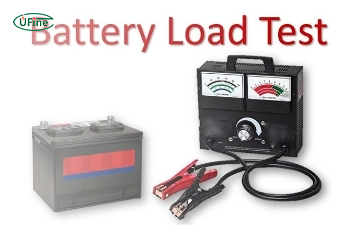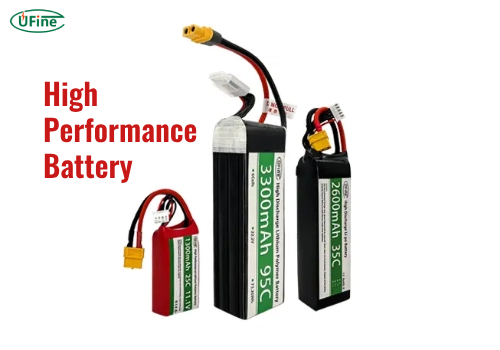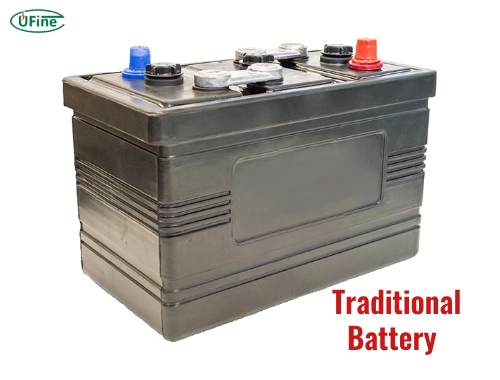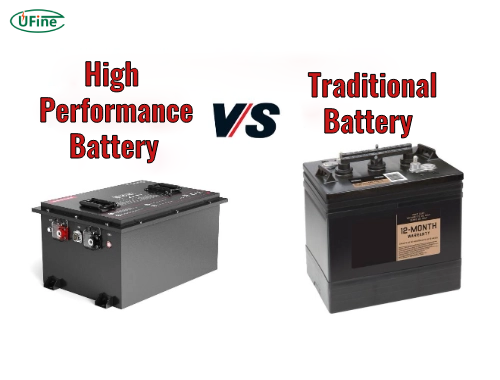
- Part 1. What are high performance batteries?
- Part 2. What are traditional batteries?
- Part 3. How do high performance batteries work?
- Part 4. How do traditional batteries work?
- Part 5. Advantages of high performance batteries
- Part 6. Advantages of traditional batteries
- Part 7. Applications of high performance batteries
- Part 8. Applications of traditional batteries
- Part 9. Cost comparison between high performance batteries and traditional batteries
- Part 10. FAQs
In the world of energy storage, high-performance batteries (HPBs) are revolutionizing how we store and use energy. These advanced batteries offer significant improvements over traditional battery technologies, making them a focal point in discussions about sustainable energy solutions. This article will provide a detailed comparative analysis of high-performance and conventional batteries, exploring their technologies, applications, advantages, and drawbacks.
Part 1. What are high performance batteries?
High-performance batteries are advanced energy storage solutions designed to deliver superior performance compared to conventional batteries. They utilize innovative technologies, such as solid-state electrolytes, which replace the liquid electrolytes found in traditional batteries.
Key Features of High Performance Batteries
- Safety: One of the standout features of HPBs is their safety profile. The solid-state design eliminates flammable liquid electrolytes, significantly reducing the risk of fires and explosions.
- Longevity: HPBs typically have a longer lifespan than traditional batteries. They can endure thousands of charge cycles without significant degradation in performance, often lasting up to 8,000 to 10,000 cycles.
- Efficiency: These batteries boast high energy densities, meaning they can store more energy in a smaller volume. This efficiency translates into longer usage times for devices and vehicles powered by HPBs.
- Environmental Impact: Many high-performance batteries are designed with sustainability in mind. They often use fewer harmful materials and have better recyclability than traditional battery technologies.
High-performance batteries are increasingly used in various applications, including electric vehicles (EVs), renewable energy systems, and portable electronics. Their ability to provide reliable and environmentally friendly power makes them critical in transitioning to cleaner energy solutions.
Part 2. What are traditional batteries?
Traditional batteries, including lead-acid and nickel-cadmium batteries, have been around for many years. These batteries rely on liquid electrolytes to facilitate chemical reactions that generate electrical energy.
Characteristics of Traditional Batteries
- Cost-Effectiveness: Traditional batteries are generally less expensive to manufacture and purchase than high-performance options. This makes them an attractive choice for many consumers and industries.
- Cycle Life: While they have a shorter lifespan than HPBs, certain traditional battery types can still perform well under specific conditions. For example, lead-acid batteries can last around 500 to 1,200 cycles, depending on usage.
- Recyclability: Many traditional battery types are fully recyclable, which helps mitigate environmental concerns at the end of their life cycle. Lead-acid batteries have a well-established recycling process that allows for the recovery of valuable materials.
Traditional batteries are commonly used in applications like automotive starting systems, backup power supplies, and consumer electronics. Despite their limitations compared to newer technologies, they remain widely utilized due to their cost advantages and established infrastructure.
Part 3. How do high performance batteries work?
High-performance batteries operate through a unique mechanism involving solid-state electrolytes. This technology allows for more efficient ion transfer between electrodes than liquid systems.
Mechanism of Action
- Ion Movement: In HPBs, ions move through the solid electrolyte during the charging and discharging. This movement is more efficient than in traditional liquid electrolyte systems.
- Electrode Interaction: The solid-state design minimizes issues related to dendrite formation (which can cause short circuits in liquid systems), enhancing safety and longevity.
- Energy Density: The solid structure allows for higher packing density of active materials, leading to increased energy storage capacity without increasing size or weight.
Combining these features enables high-performance batteries to deliver exceptional power output while maintaining safety and efficiency across various applications.
Part 4. How do traditional batteries work?
Traditional batteries function through electrochemical reactions facilitated by liquid electrolytes. The most common type is the lead-acid battery, which consists of lead dioxide (PbO2) as the positive plate and sponge lead (Pb) as the negative plate.
Basic Operation
Chemical Reaction: When discharging, sulfuric acid reacts with lead plates to produce lead sulfate (PbSO4) and water.
- Recharging: During recharging, an external current reverses this reaction, restoring the original materials.
- Energy Output: The chemical composition allows for a steady voltage output until the reactants are depleted.
Traditional battery technology has been refined over decades but still needs challenges, such as limited cycle life and lower efficiency compared to newer alternatives like HPBs.
Part 5. Advantages of high performance batteries
High-performance batteries offer several advantages that make them increasingly appealing for various applications:
Benefits
- Higher Efficiency: With efficiencies often exceeding 95%, HPBs provide more usable energy from each charge than traditional options.
- Longer Lifespan: They can last significantly longer than traditional options due to reduced wear from internal resistance.
- Safety Features: The absence of flammable liquids reduces risks associated with overheating or leaks.
- Sustainability: Many high-performance battery technologies use less harmful materials, contributing to lower environmental impact during production and disposal.
These benefits position high-performance batteries as vital in advancing technology across multiple sectors while addressing environmental concerns associated with conventional battery technologies.
Part 6. Advantages of traditional batteries
Despite their limitations compared to high-performance options, traditional batteries still hold several advantages:
Benefits
- Lower Initial Cost: Traditional batteries are often cheaper upfront, making them accessible for budget-conscious consumers.
- Robustness in Specific Applications: Traditional battery types excel in applications requiring high discharge rates or deep cycling capabilities.
- Established Recycling Processes: The recycling infrastructure for lead-acid batteries is well-developed, ensuring responsible disposal practices.
These characteristics ensure that traditional battery technologies remain relevant despite the growing popularity of high-performance alternatives.
Part 7. Applications of high performance batteries
High-performance batteries find applications across various sectors due to their superior characteristics:
Common Uses
- Electric Vehicles (EVs): Their efficiency and longevity make them ideal for powering electric vehicles, which require reliable and long-lasting energy sources.
- Renewable Energy Storage: HPBs are increasingly used in solar and wind energy systems to store excess power generated during peak production times.
- Consumer Electronics: Devices like smartphones and laptops benefit from HPBs’ lightweight and compact nature, allowing for extended usage without frequent recharging.
As industries shift towards sustainable practices, the demand for high-performance battery solutions will grow significantly.
Part 8. Applications of traditional batteries
Traditional batteries continue to be widely used in several areas despite the emergence of newer technologies:
Common Uses
- Automotive Starting Systems: Due to their reliability, Lead-acid batteries remain the standard choice for starting internal combustion engines.
- Backup Power Systems: Many uninterruptible power supplies (UPS) utilize traditional battery technologies for emergency power backup.
- Industrial Equipment: Forklifts and other heavy machinery often rely on robust lead-acid or nickel-cadmium options due to their ability to handle demanding conditions.
These applications highlight the ongoing relevance of traditional battery technologies even as innovations emerge.
Part 9. Cost comparison between high performance batteries and traditional batteries
When considering which battery technology to invest in, cost is often a significant factor:
Cost Analysis
| Feature | High Performance Batteries | Traditional Batteries |
|---|---|---|
| Initial Purchase Cost | $300-$500 per kWh | $100-$150 per kWh |
| Lifespan | 8,000 – 10,000 cycles | 500 – 1,200 cycles |
| Maintenance Costs | Low | Moderate |
| Total Cost Over Lifetime | Competitive | Higher over time |
While high-performance batteries may require a more significant initial investment—often ranging from $300-$500 per kWh—their longevity and efficiency can make them more cost-effective over time compared to traditional options that typically cost $100-$150 per kWh but need more frequent replacements due to limited cycle life.
Part 10. FAQs
-
What is the main advantage of high performance batteries?
The main advantage is their higher efficiency and longer lifespan compared to traditional options. -
Are high performance batteries safer than traditional ones?
Yes, HPBs typically use non-flammable materials that reduce risks associated with overheating or leaks. -
How do costs compare between these two types?
While HPBs have a higher initial cost ($300-$500 per kWh), they can be more cost-effective over time due to their longevity compared to traditional options ($100-$150 per kWh). -
Can I replace my traditional battery with a high performance one?
Yes, but consulting with a professional is essential to ensure compatibility with your system requirements. -
What industries benefit most from high performance battery technology?
Industries such as automotive (electric vehicles), renewable energy storage, and consumer electronics significantly benefit from HPB technology’s efficiency and longevity.
Related Tags:
More Articles

Battery Load Test: A Comprehensive Guide
Step-by-step battery load test guide for car, solar & industrial use. Learn how to load test a battery, interpret voltage charts, and avoid common mistakes.
The Comprehensive Guide to Battery Balancing and Battery Balancer
Discover how battery balancers improve lithium battery performance, lifespan, and safety. Learn types, functions, and tips to choose the right balancer.
What Is the Best Voltage for a Chainsaw Battery?
Compare 12V-80V chainsaw batteries for light pruning, medium firewood, and professional cutting. See best battery chainsaw with runtime charts and safety tips.
Lithium VS. Alkaline Batteries: A Comprehensive Comparison
Lithium batteries last 3–7× longer than alkaline and perform better in cold weather. Compare lifespan, cost, safety, and best uses to choose the right battery.
Comparing Lithium-Sulfur and Lithium-Ion Batteries: Which is Right for You?
Compare lithium-sulfur (Li-S) and lithium-ion batteries on energy, lifespan, cost, safety, and applications. Best choice for drones, EVs, and electronics.





